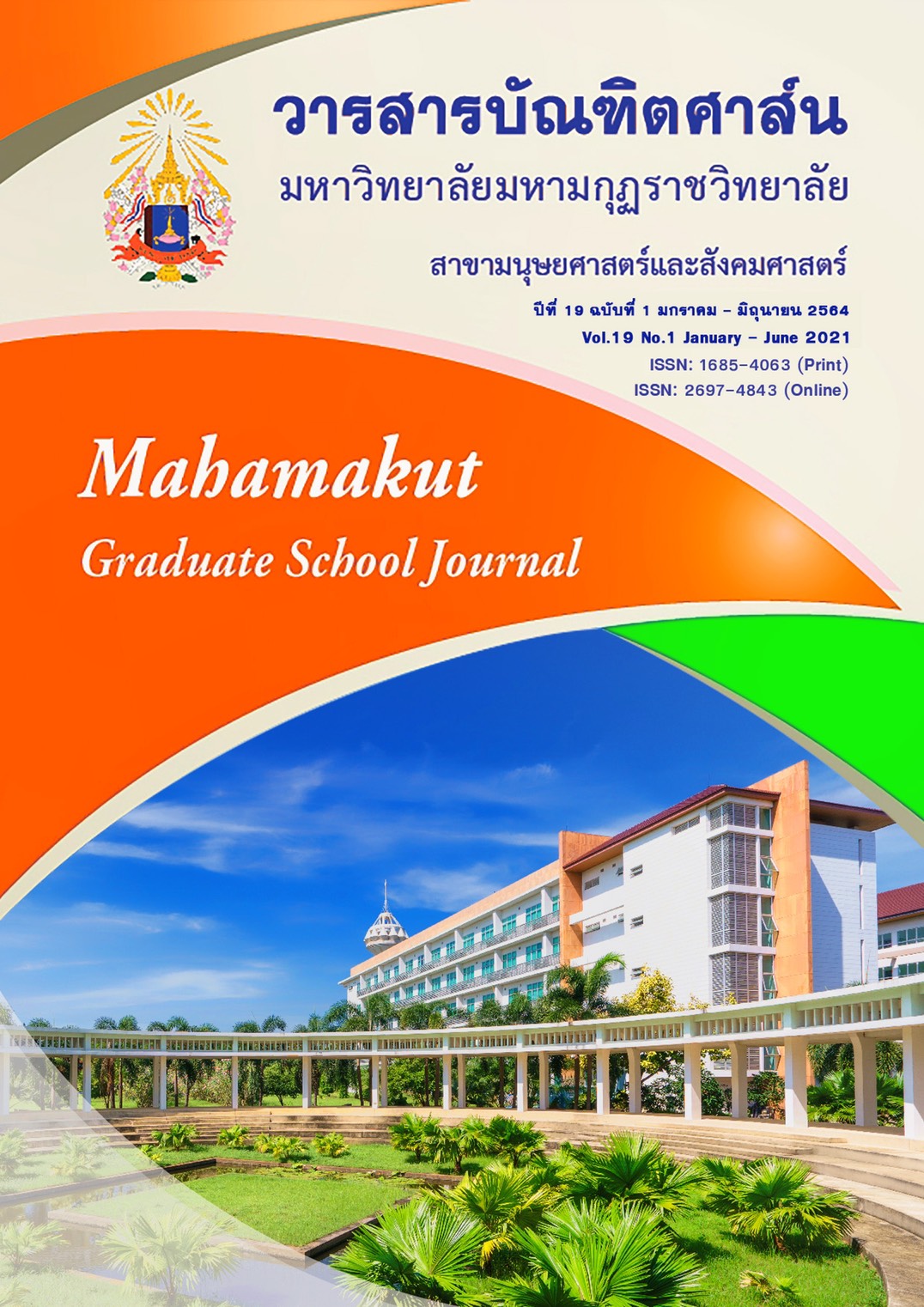นิเวศวิทยาเชิงพุทธ ศึกษาเฉพาะกรณี วัดเขาศาลาอตุลฐานะจาโร จังหวัดสุรินทร์
คำสำคัญ:
นิเวศวิทยา, นิเวศวิทยาเชิงพุทธ, วัดเขาศาลาอตุลฐานะจาโรบทคัดย่อ
บทความวิจัยนี้มีวัตถุประสงค์เพื่อศึกษาแนวคิดทฤษฎีของนิเวศวิทยาและเพื่อศึกษาเวศวิทยาเชิงพุทธ และศึกษานิเวศวิทยาเชิงพุทธ ของวัดเขาศาลาอตุลฐานะจาโร โดยศึกษาค้นคว้าจากพระไตรปิฎก และงานวิชาการอื่น ๆ ที่เกี่ยวข้องและสอดคล้องกับงานวิจัย ได้สัมภาษณ์ เก็บข้อมูลเชิงลึกจากประชากรในพื้นที่ศึกษา จำนวน 7 รูป/คน
ผลการวิจัยพบว่า
แนวคิดทฤษฎีของนิเวศวิทยา คือ โครงสร้างความสัมพันธ์ระหว่างสิ่งมีชีวิตต่าง ๆ กับบริเวณแวดล้อมของสิ่งมีชีวิตเหล่านั้น ที่มีความต้องการบริเวณที่อยู่อาศัยที่มีขนาดอย่างน้อยที่สุดมีความสมดุลเหมาะสมของสิ่งมีชีวิตนั้น ๆ เพื่อการมีชีวิตอยู่รอด อย่างปลอดภัย นิเวศวิทยาเชิงพุทธ จากผลการวิจัยพบว่า ทัศนแนวคิด อาศัยกันเกิด อาศัยกันดับ เช่นนี้ ได้มีความสอดคล้องกับหลักธรรมทางพุทธศาสนา คือ “อิทัปปัจจยตา” เมื่อสิ่งนี้ “มี” สิ่งนี้ ย่อมมี เมื่อสิ่งนี้ “ไม่มี” สิ่งนี้ ย่อมไม่มี มีความสอคล้องสัมพันธ์สืบเนื่องกับหลักธรรม “ภูตคาม”“เมตตา”“ความกตัญญูกตเวที”“กรรม” “วโนโรปสูตร ที่ 7” มีความสอคล้องสัมพันธ์สืบเนื่องกับหลักธรรม “ภูตคาม” “เมตตา” “ความกตัญญูกตเวที” “กรรม” “วโนโรปสูตร ที่ 7” นิเวศวิทยาเชิงพุทธของวัดเขาศาลาอตุลฐานะจาโร มีการจัดการระบบนิเวศมีทั้ง 3 ด้าน คือ ด้านป่าไม้ ด้านแม่น้ำ ด้านสัตว์ป่า เมื่อป่าสร้างความชุ่มชื้น ทำให้ฝนตก และเมื่อฝนตกป่าไม้ก็อุ้มน้ำไว้ไม่ให้น้ำท่วมฉับพลัน ถ้าขาดป่าไม้ฝนไม่ตกก็จะแล้ง ถ้าฝนตกลงมาน้ำก็จะท่วม ถ้าไม่มีป่าสัตว์ป่าก็อยู่ไม่ได้ มีความสอคล้องสัมพันธ์สืบเนื่องกับหลักธรรม “ภูตคาม” “เมตตา” “ความกตัญญูกตเวที” “กรรม” “วโนโรปสูตร ที่ 7”
เอกสารอ้างอิง
1) พระไตรปิฎก
มหาวิทยาลัยมหามกุฎราชวิทยาลัย พระไตรปิฎกบาลีฉบับ เล่มที่ 5,6,10 กรุงเทพมหานคร :โรงพิมพ์มหามกุฎราชวิทยาลัย ครั้งที่ 3/2524
ข้อมูลทุติยภูมิ
2) หนังสือทั่วไป/บทความจากเว็ปไซด์/วิทยานิพนธ์
มูลนิธิสืบนาคะเสถียร ไทยรัฐออนไลน์ 4 ก.ย. 2554 https://www.thairath.co.th/content/199295
พระธรรมโกศาจารย์ (ประยูร ธมฺมจิตโต).ศาสตราจารย์ ดร. โลกทัศน์ชาวพุทธ,กรุงเทพมหานคร :มหาจุฬาลงกรณราชวิทยาลัย), 2558), หน้า 223.
มูลนิธิสืบนาคะเสถียร,ไทยรัฐออนไลน์, วันที่ 11 พฤศจิกายน 2558., https://www.seub.or.th/,19/7/2563
สถานที่ศักดิ์สิทธิ์ ,Lovethailand.org : สถานที่ท่องเที่ยวในประเทศไทย,2555 : www.watkaosala.page.tl,(20/7/2563)
ดร.ประพันธ์ ศุภษร “พุทธธรรมเพื่อการอนุรักษ์สิ่งแวดล้อม” สำนักพิมพ์ : เนชั่นเอ็ดดูเทนเมนท Books, www.naiin.com/writer/207461
มั่น เสือสูงเนิน “ข้อห้ามในพระปาติโมกข์ ที่เกี่ยวกับป่าไม้ ต้นไม้ และแม่น้ำลำคลอง” วิชานิเวศวิทยาในพระไตรปิฏก,กรุงเทพฯ :จุฬาลงกรณราชวิทยาลัย,2539, หน้า 57,60,127.
พระมหาจรรยา สุทฺธิญาโณ, พุทธศาสนากับสิ่งแวดล้อม,กรุงเทพฯ: อักษรเจริญการ พิมพ์, 2536,
หน้า 7-25
เฉลิมเกียรติ แก้วหอม (บทบาทพระสงฆ์กับการอนุรักษ์ทรัพยากรป่าไม้ในเขตพื้นที่ชายแดน ไทย-กัมพูชา บริเวณเทือกเขาพนมดงรัก กรณีศึกษาวัดเขาศาลาอตุลฐานะจาโร สาขายุทธศาสตร์การพัฒนา ม.ราชภัฎสุรินทร์ ปีการศึกษา 2552
ฝ่ายศาสนากับป่าไม้.ม.ป.ป.:1 - 5
ดาวน์โหลด
เผยแพร่แล้ว
รูปแบบการอ้างอิง
ฉบับ
ประเภทบทความ
สัญญาอนุญาต
ลิขสิทธิ์ (c) 2021 มหาวิทยาลัยมหามกุฏราชวิทยาลัย

อนุญาตภายใต้เงื่อนไข Creative Commons Attribution-NonCommercial-NoDerivatives 4.0 International License.
บทความวิชาการและบทความวิจัยในวารสารฉบับนี้ถือเป็นความรับผิดชอบของผู้เขียนเท่านั้น บทความที่ได้รับการตีพิมพ์ในวารสารบัณฑิตศาส์น ถือเป็นลิขสิทธิ์ของมหาวิทยาลัยมหามกุฏราชวิทยาลัย ตามพระราชบัญญัติลิขสิทธิ์



